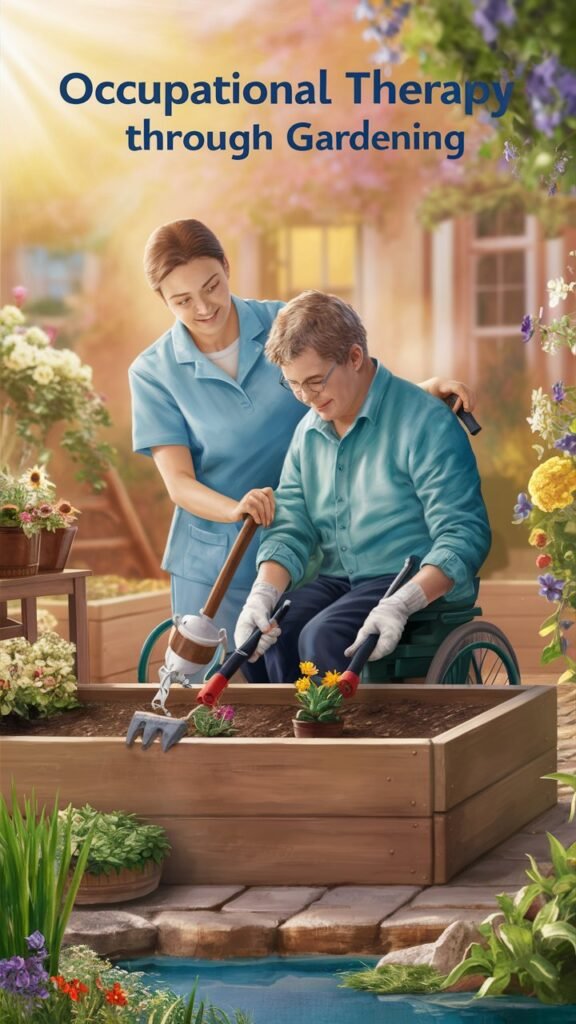Have you ever considered how something as simple as gardening can have a profound impact on your well-being? Gardening might seem like just a hobby or a way to beautify your surroundings, but it’s much more than that, especially in the realm of occupational therapy. It serves as a healing medium, showing benefits that extend well beyond the confines of planting and pruning.
Understanding Occupational Therapy
What is Occupational Therapy?
Occupational therapy (OT) is a form of therapy that helps individuals gain or regain skills needed for the daily activities of life. It’s a holistic practice, embracing the belief that health and well-being can be enhanced via engagement in daily activities, or “occupations.”
The Goals of Occupational Therapy
Occupational therapy focuses on:
- Improving Physical Function: Helping you regain strength and coordination.
- Enhancing Cognitive Function: Assisting you in developing strategies to cope with cognitive challenges.
- Promoting Independence: Making sure you can perform daily tasks independently.
- Emotional Support: Addressing psychological needs and building mental resilience.
The Therapeutic Power of Gardening
Physical Benefits
Gardening involves significant physical activity, which offers a wide range of benefits. From heavy digging and lifting to more refined, repetitive actions like planting seeds or pruning, each movement aids in developing strength, flexibility, and stamina.
Table: Physical Activities and Benefits in Gardening
| Activity | Primary Muscles Used | Health Benefit |
|---|---|---|
| Digging | Arms, Shoulders, Back, Legs | Muscle Strength, Cardio Health |
| Planting | Hands, Wrists, Fingers | Fine Motor Skills, Coordination |
| Watering Plants | Arms, Shoulders, Core | Upper Body Strength, Hydration Knowledge |
| Pruning and Weeding | Hands, Wrists, Arms | Flexibility, Hand-Eye Coordination |
Cognitive Benefits
Gardening isn’t just demanding on your body; it also engages your mind. Planning a garden layout, selecting plants, and timing your sowing and harvesting all require cognitive skills. This engagement can be particularly beneficial for those undergoing rehabilitation for cognitive impairments.
Cognitive Skills Exercised Through Gardening
- Problem-Solving: Deciding what to plant and where to plant it.
- Planning and Organization: Preparing a seasonal schedule.
- Attention to Detail: Monitoring plant health and growth.
- Memory: Remembering different plant care routines.
Psychological and Emotional Benefits
Interacting with nature has long been associated with reduced stress levels and improved mental health. The act of nurturing plants provides a sense of purpose and accomplishment, which can be particularly uplifting if you’re struggling with mental health issues or recovering from trauma.
Emotional Conditions Benefiting from Gardening
| Condition | Emotional Benefit |
|---|---|
| Anxiety | Reduced stress levels |
| Depression | Enhanced mood |
| PTSD | Sense of control and engagement |
| Alzheimer’s and Dementia | Cognitive stimulation and a sense of normalcy |
Social Benefits
Gardening can also play a crucial role in social rehabilitation. Community gardens and group projects foster social interactions, offering a platform for you to connect with others, share stories, and build relationships.
Social Skills Fostered by Gardening
- Communication: Talking about the garden and sharing tips.
- Teamwork: Working together on larger projects.
- Leadership: Taking charge of certain aspects of the garden.

Gardening Techniques in Occupational Therapy
Raised Beds and Container Gardening
One of the exciting aspects of gardening in occupational therapy is its adaptability. For individuals facing mobility constraints, raised beds or container gardens make gardening accessible. You can easily reach plants without extensive bending or squatting.
Sensory Gardens
Sensory gardens are designed to engage all of your senses. With a mix of tactile plants, aromatic herbs, and colorful flowers, these gardens provide therapeutic benefits through sensory stimulation.
| Sense | Garden Feature | Therapeutic Benefit |
|---|---|---|
| Sight | Colorful Flowers | Visual Stimulation, Relaxation |
| Smell | Aromatic Herbs and Flowers | Memory Evocation, Stress Reduction |
| Touch | Textured Leaves | Tactile Stimulation, Grounding |
| Sound | Wind Chimes, Water Features | Auditory Stimulation, Tranquility |
| Taste | Edible Plants | Nutritional Insight, Sensory Engagement |
Horticultural Therapy
Horticultural therapy is an advanced approach that combines gardening activities with specific therapeutic goals. An occupational therapist may use horticulture tasks that align with your personal treatment plan, targeting both physical and psychological needs.
Case Studies and Real-Life Examples
Rehabilitation After Physical Injury
Consider Sarah, a 45-year-old woman recovering from a severe leg injury. Through guided gardening tasks, she gradually improved her leg strength and coordination. Activities like kneeling to plant seeds and standing to water the garden provided low-impact physical exercise, aiding her recovery.

Cognitive Rehabilitation for Stroke Patients
Another case involves John, a 60-year-old stroke survivor. By participating in garden planning and maintenance, John found an engaging way to work on his cognitive rehabilitation. Tasks such as sequencing plant schedules, following gardening instructions, and recalling plant information helped John significantly improve his cognitive abilities.
Mental Health Recovery
For mental health, gardening has profoundly benefited individuals like Emily, a 30-year-old suffering from anxiety and depression. The routine and responsibility of tending to a garden gave Emily a focus, providing an emotional anchor and a sense of achievement that was instrumental in her mental health recovery.

Developing a Therapeutic Garden: Tips and Guidelines
Personalizing Your Garden
One of the first steps in leveraging gardening for therapy is to tailor it to your needs and preferences. Choose plants that you find engaging and enjoyable. Whether it’s the aroma of lavender that calms your nerves or the tactile stimulus of lamb’s ear plants, personalizing your garden can significantly enhance its therapeutic effectiveness.
Incorporating Accessibility
Ensure that your garden design includes easy-to-navigate pathways and raised beds if needed. Use tools with ergonomic handles to reduce strain on your hands and wrists. If you face significant mobility challenges, consider vertical gardening techniques, which make use of walls and other upright structures.
Seasonal Planning
Gardening is an activity that changes with the seasons, offering you varying challenges and rewards throughout the year. Engage in seasonal planning to keep the therapy dynamic and aligned with the natural cycles.
- Spring: Seed planting, soil preparation, and weeding.
- Summer: Pruning, watering, and combating pests.
- Autumn: Harvesting, preparing plants for winter, and composting.
- Winter: Planning for the next year, maintenance work, and indoor gardening such as growing herbs on windowsills.
- 【3pcs garden too set】 All you need to give your garden the best start. Ideal for a variety of tasks including digging, w…
- 【Ergonomic & Comfortable】The padded ergonomic soft-grip ergonomic handles provide exceptional grip and are comfortable t…
- 【Heavy Duty & Durable】Heavy Duty Stainless Steel high hardness, durable, not easy to rust and broken.Rust-proof, extreme…
- UNIVERSAL CUFF – Fits larger hands and larger objects such as Mops and Brooms, Toilet Wand, Shower Head, Gardening Tools…
- EXTRA SENSORY FIT – Made of soft stretchy silicone that securely grips against the skin and does not need to be tight on…
- PREMIUM MATERIALS – Aqua EazyHold is made with highly durable, soft and flexible silicone.

The Future of Gardening in Occupational Therapy
Research and Developments
The understanding and acceptance of gardening as a significant component of occupational therapy are growing. Research continues to explore the multidimensional benefits of this activity, from physiological improvements to psychological well-being.
Integration with Technology
Advanced technology such as gardening apps can help track your progress, manage plant care routines, and even connect you with gardening communities. Virtual reality (VR) gardens are also being explored as a therapeutic tool, especially for individuals with severe mobility restrictions.
How to Get Started
If you’re intrigued by the idea of using gardening as a therapeutic tool, connect with an occupational therapist experienced in horticultural therapy. They can provide you with a structured, personalized plan to start your gardening journey.
Basic Tools and Supplies
Begin your journey by securing some basic gardening tools and materials. These may include:
- Ergonomic hand tools
- Raised beds or container pots
- Quality soil and compost
- A variety of easy-to-grow plants or seeds
Safety Precautions
While gardening is generally a safe activity, it’s important to keep some precautions in mind:
- Always use sun protection.
- Stay hydrated.
- Use tools properly to avoid injury.
- Be mindful of allergies to plants or insects.
Conclusion
Incorporating gardening into your occupational therapy can offer you a multifaceted therapeutic experience. From physical rehabilitation and cognitive improvements to emotional and social benefits, gardening presents a holistic approach to healing and well-being. Through personalized, accessible, and seasonally varied activities, this practice not only nurtures your body and mind but also brings a profound sense of satisfaction and joy. Whether you wish to plant a sensory garden full of fragrant herbs or develop a community garden project, your journey in cultivating healing through gardening is bound to be a rewarding one.

My name is Michelle Warren, and I’m the founder of Peaceful Gardening. As a 10-year breast cancer survivor, I’ve discovered the profound therapeutic power of gardening. This journey has not only helped me recover but has also become my passion and a source of ongoing peace and joy.
Peaceful Gardening was born from my desire to share the healing benefits of gardening with others. Whether you’re facing health challenges, dealing with stress, or simply looking to connect more deeply with nature, this space is for you.
Over the past decade, I’ve cultivated not just plants, but a deep understanding of how gardening can positively impact mental health. I’ve worked with local community gardens, led workshops on mindful gardening practices, and collaborated with mental health professionals to develop gardening-based stress reduction programs.
Peaceful Gardening was born from my desire to share the healing benefits of gardening with others. Whether you’re facing health challenges, dealing with stress, or simply looking to connect more deeply with nature, this space is for you.
Here, you’ll find evidence-based advice on using gardening as a tool for mindfulness, stress relief, and emotional healing. I share personal stories, practical tips, and scientifically-backed information on how to create your own therapeutic garden space, no matter the size of your yard or balcony.
My mission is to help you discover the joy, peace, and healing that comes from nurturing plants and connecting with nature. Join me in exploring how the simple act of tending to a garden can transform your mental and emotional wellbeing.
Welcome to Peaceful Gardening – let’s grow together towards better mental health!”


